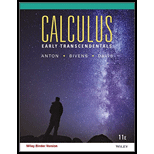
The amount of water in a tank
(a) At what rate is the water running out at the end of
(b) What is the average rate at which the water flows out during the first
Want to see the full answer?
Check out a sample textbook solution
Chapter 2 Solutions
Calculus Early Transcendentals, Binder Ready Version
Additional Math Textbook Solutions
Precalculus Enhanced with Graphing Utilities
Calculus 2012 Student Edition (by Finney/Demana/Waits/Kennedy)
Calculus: Early Transcendentals (3rd Edition)
Precalculus: Mathematics for Calculus (Standalone Book)
Precalculus Enhanced with Graphing Utilities (7th Edition)
- A driver of a car stopped at a gas station to fill up his gas tank. He looked at his watch, and the time read exactly 3:40 p.m. At this time, he started pumping gas into the tank. At exactly 3:44, the tank was full and he noticed that he had pumped 10.7 gallons. What is the average rate of flow of the gasoline into the gas tank?arrow_forwardThe kinetic energy E of an object varies jointly with the object’s mass m and the square of the object’s velocity v . An object with a mass of 50 kilograms traveling at 16 meters per second has a kinetic energy of 6400 joules. What is the kinetic energy of an object with a mass of 70 kilograms traveling at 20 meters per second?arrow_forward


 Trigonometry (MindTap Course List)TrigonometryISBN:9781337278461Author:Ron LarsonPublisher:Cengage Learning
Trigonometry (MindTap Course List)TrigonometryISBN:9781337278461Author:Ron LarsonPublisher:Cengage Learning


